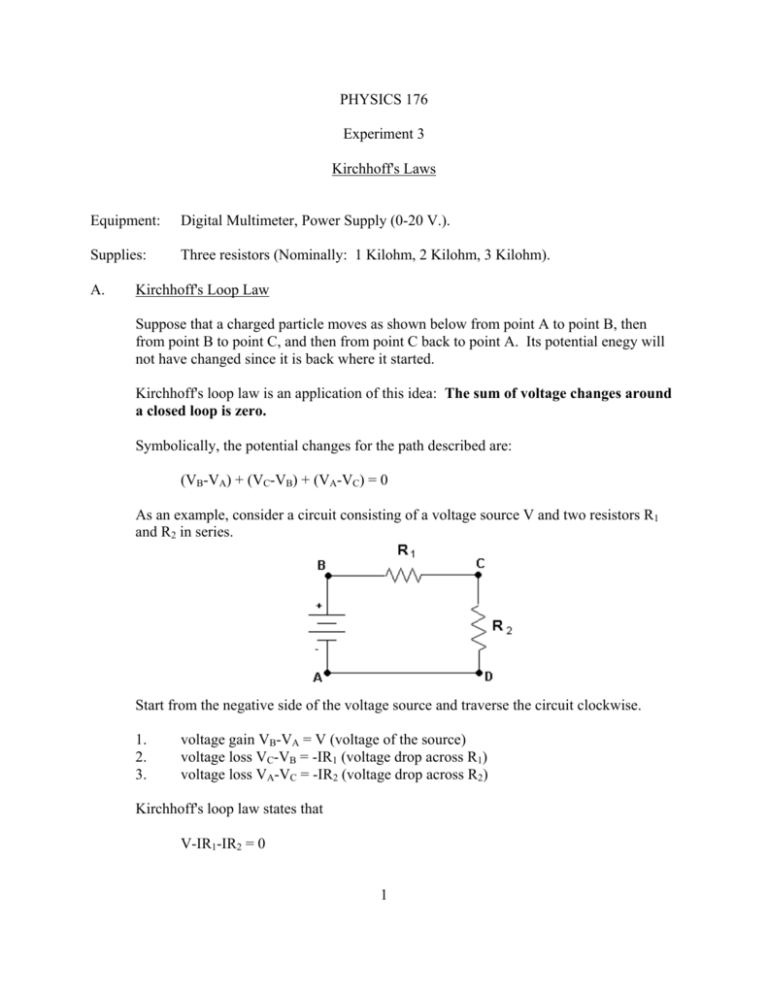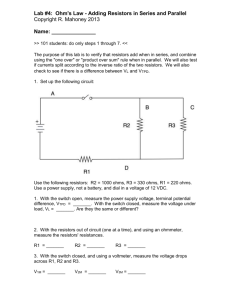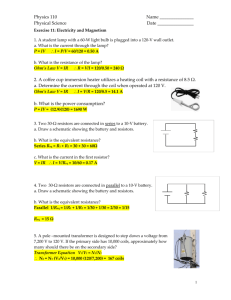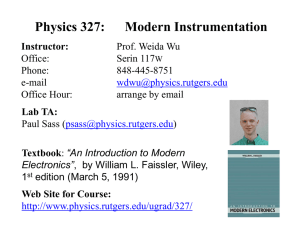Kirchhoff's Laws
advertisement

PHYSICS 176 Experiment 3 Kirchhoff's Laws Equipment: Digital Multimeter, Power Supply (0-20 V.). Supplies: Three resistors (Nominally: 1 Kilohm, 2 Kilohm, 3 Kilohm). A. Kirchhoff's Loop Law Suppose that a charged particle moves as shown below from point A to point B, then from point B to point C, and then from point C back to point A. Its potential enegy will not have changed since it is back where it started. Kirchhoff's loop law is an application of this idea: The sum of voltage changes around a closed loop is zero. Symbolically, the potential changes for the path described are: (VB-VA) + (VC-VB) + (VA-VC) = 0 As an example, consider a circuit consisting of a voltage source V and two resistors R1 and R2 in series. Start from the negative side of the voltage source and traverse the circuit clockwise. 1. 2. 3. voltage gain VB-VA = V (voltage of the source) voltage loss VC-VB = -IR1 (voltage drop across R1) voltage loss VA-VC = -IR2 (voltage drop across R2) Kirchhoff's loop law states that V-IR1-IR2 = 0 1 Then V = IR1 + IR2 V = I(R1 + R2) The equivalent resistance of R1 and R2 in series is V/I = R1 + R2 = Rs In general, if there are n resistors in series, then the equivalent resistance is given by Rs = R1 + R2 + R3 + ......... + Rn B. Kirchhoff's Point Law The conservation of electric charge, when applied to circuits, gives Kirchhoff's point of law: The net current flowing into a junction equals the net current flowing out. As an example, consider a circuit consisting of a voltage source connected to two resistors in parallel. Kirchhoff's current point states that: I = I1 + I2 Kirchhoff's loop law applied to the two loops above states that V = I1R1 and V = I2R2 The equivalent resistance of R1 and R2 in parallel is V/I = V/(I1 + I2) = 1/(1/R1 + 1/R2) = (R1R2)/(R1 + R2) = Rp In general, if there are n resistors in parallel, then the equivalent resistance is given by 1/Rp = 1/R1 + 1/R2 + ……………………..+ 1/Rn 2 Procedure - Experiment 2 A. Resistors in Series 1. Measure the values of the three resistors using the digital ohmmeter. 2. Connect the three resistors in series, as shown. Measure the resistance of this series combination with the digital ohmmeter. Compare this measurement with the value computed from equivalent resistance equation for resistors in series. 3. Set up the circuit shown below and measure the current I. The power supply should be set to 12 volts. Compute the resistance of the series combination of resistors from V/I. 3 4. Remove the digital milliammeter from the circuit and switch it to an appropriate voltage range. Measure the voltages V1, V2, V3 across the three resistors. For example, the diagram below shows the measurement of V2. Verify Kirchhoff's loop law: V1 + V2 + V3 = 12 volts. 5. Compute the voltage drops across the three resistors by using the voltage divider equations: V1 = 12 V(R1/Rs) B. 1. V2 = 12V(R2/Rs) V3 = 12V(R3/Rs) Connect the three resistors in parallel, as shown. Measure the resistance of this parallel combination with the digital ohmmeter. Compare this measurement with the value computed from the equivalent resistance equation for parallel resistors. 4 2. Set up the circuit shown below and measure the total current I. Compute the resistance of the parallel combination of resistors from V/I. Compute the resistance of the parallel combination of resistors from V/I. 3. Put the digital milliammeter in each branch of the parallel resistor combination and measure the currents I1, I2, I3. Verify Kirchhoff's current law: I1 + I2 + I3 = I 4. Compute the three currents by using the current divider equations: I1 = I(Rp/R1) I2 = I(Rp/R2) I3 = I(Rp/R3) where Rp is the equivalent resistance of the parallel combination. C. Resistors in a Series and Parallel Combination 1. Connect the three resistors as shown below. \ Measure the resistance of this combination with the digital ohmmeter. The equivalent resistance of this combination is given by: 1/Req. = 1/R1 + 1/(R2+R3) Use this equation to compute Req and compare with the measured value. 5 2. Set up the circuit shown below. Compute the current delivered by the battery using I = V/Req. Using the digital milliammeter measure I, I1, I2, and I3. Switch the meter to an appropriate voltage range and measure V1, V2, and V3. 3. Connect the three resistors as shown below. Measure the resistance of this combination with the digital ohmmeter. The equivalent resistance of this combination is given by: Req. = R1R2/(R1+R2) + R3 Use this equation to compute Req and compare with the measured value. 6 4. Set up the circuit shown below. Compute the current delivered by the battery using I = V/Req. Using the digital milliammeter measure I, I1, I2, and I3. Switch the meter to an appropriate voltage range and measure V1, V2, and V3. 7 Name______________________________ Data Sheet - Experiment 2 Section # ____________ A. Resistors in Series 1. Measured values of the three resistors R1 = 2. kΩ R2 = mA. kΩ (12 V.)/I = volts V1 + V2 + V3 = V2 = volts V3 = volts volts V2 = volts Resistors in Parallel 1. Measured value of the parallel combination Rp (measured) = kΩ Computed value of the parallel combination Rp (computed) = 2. volts Computed values of V1, V2, V3 V1 = B. kΩ Measured values of V1, V2, V3 V1 = 5. kΩ Computed value of the series combination using V/I I= 4. R3 = Measured value of the series combination Rs(measured) = 3. kΩ kΩ Computed value of the parallel combination using V/I I= mA. (12 V.)/I = kΩ 8 V3 = volts 3. Measured values of I1, I2, I3 I1 = mA. I1 + I2 + I3 = 4. 2 = mA. I3 = mA. I3 = mA. mA. Computed values of I1, I2, I3 I1 = C. I mA. I2 = mA. Resistors in a Series and Parallel Combination 1. Measured value of the combination Req (measured) = kΩ Computed value of the combination Req (computed) = 2. kΩ Computed value of the current. I= mA Measured values of I, I1, I2, I3 I= mA I1 = mA I2 = What relations do you see between these currents? 9 mA I3 = mA Measured values of V1, V2, V3 V1 = Volts V2 = Volts V3 = Volts What relations do you see between these voltages? Would any readings change if R1 and R2 were interchanged? 3. Measured value of the combination Req (measured) = kΩ Computed value of the combination Req (computed) = 4. kΩ Computed value of the current. I= mA Measured values of I, I1, I2, I3 I= mA I1 = mA I2 = mA What relations do you see between these currents? 10 I3 = mA Measured values of V1, V2, V3 V1 = Volts V2 = Volts V3 = What relations do you see between these voltages? Would any readings change if R1 and R2 were interchanged? 11 Volts







